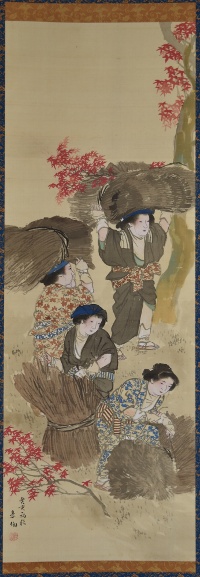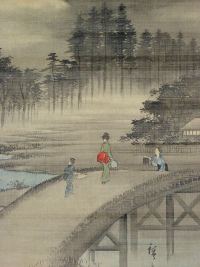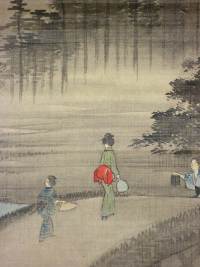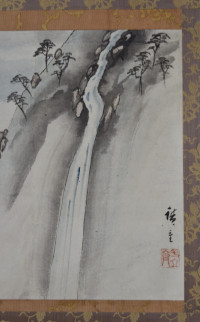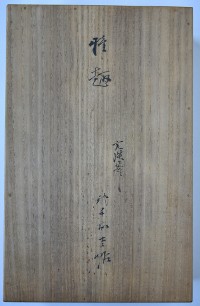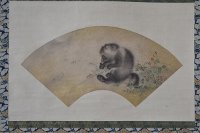/category/archive/page/4/
Yamaguchi SOKEN (1759-1818)

Click here to view image full size.
A fine pair of paintings: One showing women of Ohara; a mountain village north of Kyoto. These Oharame collected brushwood and firewood in the fall to sell in Kyoto. They are often depicted and obviously caused a stir when they entered Kyoto to ply their trade. Evidently the custom has been going on since the 12th century. The other painting shows spring tea-leaf picking at Uji. An area located at the southern edge of Kyoto prefecture. Shincha, the new tea of the year, was prized and collected at the beginning of May. Soken was one of Okyo’s ten best pupils, lived in Kyoto, and is known for his fine illustrated books, such as: Yamato jimbutsu gafu, 1800; Yamato jimbutsu gafu kohen, 1804; Soken sansui gafu 1818 and others. Sumi and full colour on paper, each 39 x 13.5 in; 99 x 34.3 cms. Fine, fresh condition and newly mounted. Each signed Mizunoto i Soken, Soken painted in the Boar Year, 1803 with seal Soken.
Status: Sold

Click here to view image full size.
Nishiyama HOEN (1804-1867)
Click here to view image full size.
An original painting showing the oiran Eguchi on a white elephant. The origins of this story seem to go back to a recorded conversation the poet-monk Saigyo (1118-1190) had with a prostitute named Eguchi giving rise to numerous legends. Eguchi is shown as a manifestation of the Budhisattva Fugen whose usual vehicle is a large white elephant. Hoen, one of the best shijo painters of his time, lived in Osaka and was a pupil of Keibun. Full colour on silk, 36.5 x 13 in; 92.7 x 33 cms. Mount showing signs of wear but image in good condition. Signed Hoen with seal (?) – Seisho.
Status: Sold
Nagasawa ROSETSU (1754-1799)

Click here to view image full size.
An original painting, 47.25 x 16 in; 120 x 40.5 cms. Sumi and touches of very light colour on paper. Shows cranes flying in a mountainous landscape. Rosetsu is considered one of the most important artists of the late Edo period but little is known of his short life – he died at forty-five – apart from the fact that he studied and was one of the top disciples of Maruyama Okyo. He is labelled an “eccentric” painter as he defies easy classification. His brushwork is a tour de force and he is known for his expressive depictions of animals. Signed Rosetsu sha with large Gyo seal with the top right corner broken indicating being painted after May 1792-94. In good condition.
Status: Sold
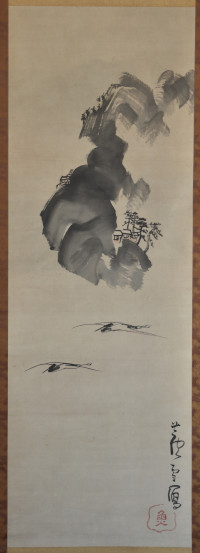
Click here to view image full size.
Imao KEINEN (1845-1924)
Click here to view image full size.
Probably the best known artist of his time and famous for his realistic depictions of birds and flowers. Two koi or carp swim beneath a rock with an overhanging white mountain rose. Ink, colour, gofun and gold on silk. Original mount with ivory rollers. A double kiri-wood box inscribed by Keinen’s son Keisho with date Showa 13, 1938 and a guarantee of authenticity. He entitles the painting Nobara yuri, “Koi playing under a wild rose.” Image size: 44.5 x 14.5 in; 113 x 36.5 cms. Slight crease, otherwise good condition. Signed Keinen.
Status: Sold
Watanabe NANGAKU (1767-1813)

Click here to view image full size.
A large original painting, full colour on silk, image size 46 x 21.75 in; 116.8 x 55.2 cms. This impressive painting shows two courtesans of the Shimbara (red-light) district of Kyoto and their attendants. Nangaku was one of Maruyama Okyo’s best pupils showing great dexterity in impromptu sketches (sekijo) as well as producing paintings of bijin which show ukiyo-e influences. He was responsible for the introduction of the Maruyama style to Edo where he lived for approximately three years late in his career before moving back to Kyoto where he died. He was included in the first exhibition in Edo of contemporary calligraphies and paintings organised by Sawara Kikuu in 1804. A comparable painting is in the Art Gallery of New South Wales, Australia, acc. no. 121.1980. (See Jack Hillier, The uninhibited brush, Hugh M. Moss, 1974, pp. 93-99.) In very good condition with double box. Signed Nangaku with seals Genzan and Iseki.
Status: Sold
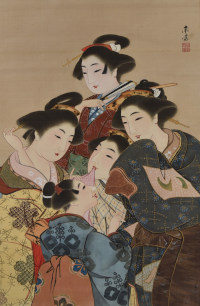
Click here to view image full size.
Teisai HOKUBA (1771-1844)

Click here to view image full size.
An original painting, full colour on silk, image size 37.5 x 12.75in; 95.2 x 32.3 cms. One of Hokusai’s earliest and best pupils. Produced a few surimono, also illustrated books, but is best known for his paintings of bijin, often shown promenading along the Sumida River, as here. Above is flowering cherry blossom setting the scene in late March or early April. The background is in Kano ink-wash showing boats on the river and below a ferry landing stage which she is presumably making her way towards. A similar painting is in the BM, illustrated in Ukiyo-e Paintings in the British Museum, Timothy Clark, 1992, p. 120, p. 169. Painted c 1830-44. In good condition. Signed Teisai with seal Hokuba gain.
Status: Sold

Click here to view image full size.
Mori SOSEN (1747-1821)

Click here to view image full size.
An original painting, sumi and light colour on silk, image size 32 x 11.5 in; 81.3 x 29.2 cms. His life is not well documented but he is known to have studied under the Kano artist Yamamoto Joshunsai (? -1781) before being drawn into Mauyama Okyo’s (1735-1795) artistic circle and his style is more Shijo than anything else. His animal paintings were evidently highly valued by Okyo. He was an immediate favourite with eastern collectors because of his monkey paintings at which he excelled, although he was more versatile than literature implies and highly accomplished at drawing other animals. But his images of monkeys take precedence and he is considered the pre-eminent painter, east or west, on this subject. It is alleged that he lived in the woods for three years eating fruit and nuts to study the monkeys and other animals and is also supposed to have had a cage of monkeys at the back of his house to better observe them. Shows two Japanese macaque monkeys, known as the snow monkeys, eating chestnuts. Signed Sosen hitsu with seal Shusho. Minor cracks, otherwise very good condition.
Status: Sold

Click here to view image full size.
Ichiryusai HIROSHIGE (1797-1858)
Click here to view image full size.
An important original Hiroshige painting. Sumi and colour on grey silk, 22.5 x 13.75 inches, 57 x 35 cms. An atmospheric scene showing an evening view at Tamegawa. Villagers hurrying home across a bridge to avoid an approaching thunderstorm. Lightning flashing above. This is a well known painting and has been illustrated in a number of books, including Ukiyo-e Art, Number 18, Memorial Exhibition of Hiroshige, The Japan Ukiyo-e Society, 1968, pl.20. Very good condition; fully mounted with double box and ivory ends. Signed Hiroshige fude with Ichiryusai seal. Hiroshige signature c. 1848- 52.
Status: Sold
Kawanabe KYOSAI (1831-1889)
Click here to view image full size.
A fine painting, sumi on paper, showing three crows on the boughs of a willow tree. Crows were one of Kyosai’s favourite subjects and, apart from paintings, he used them in various formats: fan prints, oban and dai-oban prints. There are also numerous copies of his crow paintings. Signed Kyosai ga. 51 x 18.5 inches, 129.5 x 47 cms. Very good condition with original mount and rollers.
Status: Sold
Kawanabe KYOSAI (1831-1889)

Click here to view image full size.
An original painting, full colour on silk, image size 41.25 x 16.2 in; 114.8 x 41 cms. A draughtsman of great dexterity with a wild, often bizarre, imagination. Loved sake, sometimes painting under its influence. At an early stage studied under Kuniyoshi, then Maemura Towa and later Kano Chinshin before becoming an independent painter at 27. Adept at highly finished paintings but also produced a large corpus of spontaneous paintings. This is one of Kyosai’s favourite themes: to juxtapose a beauty with an unlovely character; in this case a seated skeleton smoking.
Signed Seisai Kyosai ga with seal Kyosai in. In very good condition apart from some minor creases.
Status: Sold

Click here to view image full size.
Maki BOKUSEN (1736-1814)
Click here to view image full size.
A fine original painting, full colour on silk, 40.5 x 12.5 in; 102.9 x 31.7 cms showing a beauty reading a long (love ?) letter. Her maid on the floor beside her. Bokusen was a pupil of both Utamaro and Hokusai although he had an independent style with Hokusai elements in his painting. He was not only a painter but printmaker and book illustrator with such books as: Bokusen gafu (1809), Hitoyo banashi (1810) etc. Painted c1810s.
Very good condition. Signed and sealed Bokusen. See my Blog on this update.
Status: Sold
Matsui KEICHU (Active 1785-1819)

Click here to view image full size.
A wonderful original painting, full colour on silk, image size 35 x 12.75 in; 89 x 32.5 cms. Shows three of the leading actors around 1800: Segawa Kikunojo III (above); Iwai Kumesaburo I (below left); Ichikawa Hakuen I (below right). The first two onnagata dressed in female attire. Kikunojo is the subject of the famous bust portrait by Sharaku showing him as Oshizu, the wife of Tanabe Bunzo. Hakuen (Ichikawa Danjuro V) was one of the most famous and popular actors of his time. He is having tea served to him from a teapot by Kumesaburo watched by Kikunojo. Keichu, a Nagasaki painter, is known for his famous painting of a tiger cleaning its paw in the Minneapolis Institute of Art. A highly accomplished painting in very good condition. Sealed Matsui Keichu.
Status: Sold

Click here to view image full size.
Katsushika TAITO II (Active c. 1810-1853)

Click here to view image full size.
An original fan painting, sumi and light colour on prepared paper, 7.5 x 21.5 in; 19 x 54.5 cms. Shows a badger disguised as a priest. This is the same story as is illustrated in Yoshitoshi’s Shingata sanjurokkaisen, “Thirty-six Supernatural Beings in New Forms” showing the badger at Morinji Temple that could turn itself into a teakettle. Taito II was given the go of Taito by Hokusai, whose pupil he was, in 1820. The fan has the original rib marks and has minor wear, but is in generally good condition. The paper treated with mica. Signed Taito hitsu with Hyaku seal.
Status: Sold
Katsushika HOKUSAI (1760-1849)

Click here to view image full size.
An original painting, full colour on paper, 48.75 x 13.75 in; 124 x 35 cms. Shows Kintaro (aka Sakata no Kintoki) riding a large Chinese shishi lion. Kintaro was a child of prodigious strength who had a vermillion-coloured body. He is often depicted with the mountain creatures from Mount Ashigara where he was raised and in particular wrestling with giant mountain bears. He carries his huge battle-axe. Riding lions/tigers is illustrated elsewhere: specifically Kato Kiyomasa (Watonai) hunting and eventually subduing tigers in Korea. There are also images of Kintoki riding a bear. Signed Hachijuhachi rojin Manji hitsu, “Brush of Manji, old man of eighty-eight.” Seal Hyaku, “Hundred.” Twenty-six paintings are known from his eighty-eighth year, although given the attrition rate for paintings, he probably produced many more.
The painting is a wonderful example of Hokusai’s free handling of the brush style on a full kakemono. Some slight creasing, otherwise good condition.
Status: Available

Click here to view image full size.
Tsukioka YOSHITOSHI (1839-1892)

Click here to view image full size.
A fine and large original painting, sumi and light colour on silk. Image size 45.5 x 20.25 in; 115.5 x 51.5 cms. Shows Kato Toranosuke (1562-1611) and Yamaji Shogen (1546-1583) locked in combat having fallen over a cliff into a river. A full moon above. Toranosuke (Kiyomasa), a bodyguard of Toyotomi Hideyoshi, was one of the “Seven Spears of Shizugatake,” Shizugatake no shichi-hon-yan. His adversary is Yamaji Shogen of Katsuie Shibata’s army. (In fact, he defected to Katsuie from Hideyoshi during the battle and was killed there – presumably by Toranosuke .) The battle of Shizugatake was in 1583.
Signed Ikkaisai Yoshitoshi hitsu. Signature of c. mid 1860s. Recently remounted and in fine condition. The detail on the armour and accoutrements is exceptional.
Status: Sold
Ishikawa TOYONOBU (1711-1785)

Click here to view image full size.
A very fine original painting, sumi and colour on paper with extensive laquer and a large emossed gold floral pattern on the bijin’s kimono; other areas in gold. Image size 35.25 x 17.75 in; 89.5 x 45 cms. Shows an elegant beauty holding up an haori to slip it over the shoulders of a seated nobleman. There is a great feeling of tenderness between the couple in this beautiful painting. In fact Toyonobu produced a print of this exact subject but showing the actors Nakamura Kiyosaburo I as Okiku and Ichimura Kamezo I as Kosuke, a pair of lovers, who were in the play Fujito nikki in 7/1751. Toyonobu must have liked the design and produced this painting but of just the protagonists. See this link in google
for the published print.
Toyonobu was a pupil of Nishimura Shigenaga and his style is also indebted to Okumura Masanobu. Produced some of the most exquisite kakemono-e, hashira-e and large obans of this period which, when they come onto the market, fetch considerable sums of money. (See, for example, Christies auction, N.Y., 18/9/2002, lot 6, ex Vever collection.) For a fine collection of his work, see The Clarence Buckingham Collection of Japanese Prints. The Primitives, 1955, A.I.C., pp. 199 – 229, nos. 1 – 58. Signed Ishikawa Shuha Toyonobu zu with seals Ishikawa uji and Toyonobu. Illustrated in colour in the exhibition catalogue of the Fuchu Art Museum, Artists of the Three Capitals-Learning About Edo Through Kyoto and Osaka, Kaneko, Nobuhisa, Oto, Yumiko, 2012, No. 67, p. 92. The cataloguing gives the play as Hiyoku no kagamon but this is most likely a dance that served as the finale. Hiyoku can mean “wings abreast” and hiyoku no tori, the “hiyoku birds” were a mythical couple who shared a single pair of wings, i.e. two lovers. In fine condition, especially given the age. Painted c. 1751.
Status: Sold
Utagawa KUNITSUGU (1800-1861)

Click here to view image full size.
An original painting, sumi and colour on silk with extensive splashed and applied gofun. Image size 29.25 x 13.25 in; 74.25 x 33.75 cms. A rare pupil of Toyokuni. Another fine painting by him is in the Minneapolis Institute of Art showing Lady Tokiwa fleeing with her children in the snow. Gift of the Clark Center for Japanese Art and Culture, 2013.29.170. Shows an eloping (?) couple standing in heavy snow shielded by his umbrella. Signed Kunitsugu fude. Seal unread. Very good condition.
Status: Sold
Utagawa HIROSHIGE (1797-1858)

Click here to view image full size.
An original painting, sumi and light colour on paper, image size 13.5 x 20 in; 34.3 x 50.8 cms. Shows the Shiraito no Taki waterfall at Hakone. The water, originating from Mount Fuji, flows over the edge of a 20 meter high cliff in thin white streams reminiscent of silk threads (hence the name Shiraito). Sold with the lid of a previous box which has a guarantee by Kazuo Inoue (a well known expert on Ukiyo-e [1889-1946] dated 1943 which gives the painting as having been done 1845-1848). In very good condition. Signed Hiroshige with Ichiryusai seal.
Status: Sold
Kawanabe KYOSAI (1831-1889)

Click here to view image full size.
An original painting, sumi on paper, image size 36.75 x 12 in; 93.3 x 31.7 cms. A draughtsman of great dexterity with a wild, often bizzare, imagination. Loved sake, sometimes painting under its influence. At an early stage studied under Kuniyoshi, then Maemura Towa and later Kao Chinshin before becoming an independent painter at 27. Adept at highly finished paintings but also produced a large corpus of spontaneous paintings. Shows a crow perched on a branch with a singing sparrow below. This was the subject he was most famous for and there were many copies.
In very good condition, remounted and with futomaki. Signed Joku Kyosai zu with seal Bankoku tobu, “Flying in, or to, many lands.”
Status: Sold
Nishiyama KAN’EI (1834-1897)

Click here to view image full size.
A gajo (album) of 21 original paintings by Nishiyama Kan’ei, the son and pupil of Nishiyama Hoen. They both worked in Osaka and Kan’ei carried on the Shijo school tradition. Relatively few paintings and drawings by Kan’ei survive but based on these and his fine Kan’ei gafu, published in 1886, it is evident he was an accomplished artist. The postscript to the album is an authentication by Takebe Hakuoh (1871-1927) stating that they are original works by the master. He studied under Kan’ei. Comes with the original box. The album and box in excellent condition. Sumi and light colour on paper mounted on gold-flecked boards. All paintings sealed Kan’ei.
Status: Sold
Katsukawa SHUNSHO (1726?-1792)

Click here to view image full size.
An original painting, sumi and full colour on silk, 32.25 x 10 in; 82 x 25.5 cms. An important print artist and his paintings being considered one of the glories of Ukiyo-e. Produced a considerable number of hosoban actor prints from the late 1760s on as well as collaborating on the Ehon butai ogi illustrated book with Buncho in 1770 and Seiro bijin awase sugata kagami with Kitao Shigemasa in 1776. He had many pupils including Shunko, Shun’ei and Hokusai. Shows a court beauty reclining and reading a book. The painting of the face, hair and the lacquer stand holding the cloth screen are exceptional. Painted c. 1789. In very good condition.
Signed Katsu Shunsho ga with seal Jui.
Status: Sold

Click here to view image full size.
Utagawa HIROSHIGE (1797-1858)

Click here to view image full size.
An original painting, sumi and light colour on silk, 13.5 x 20.5 in; 34.5 x 52 cms. Shows the renowned Husband and Wife rocks, Meoto Iwa, “Married Couple Stones,” off Futami, Mie, Japan. At this time – c. late 1840s – many thin ropes were used to tie the couple together. They are now joined by a single large shimenawa – a rope of rice straw. The larger (male) rock called Izanagi has a small torii at the top. The smaller (female) rock is called Izanami. They are sacred to the Shinto religion and worshippers flock to the neighbouring Futami Okitama Shrine, which is dedicated to the food goddess Miketsu. The ancient Shinto custom of worshipping stones is called Iwakura. A fine Hiroshige painting.
Signed Hiroshige ga with large Ichiryusai seal. In good condition with interesting old mount.
Status: Sold

Click here to view image full size.
Ichiryusai HIROSHIGE (1797-1858)

Click here to view image full size.
A charming small painting in shijo style obviously from a gajo of such sketches. Shows a flowering plum branch loosely tied to another branch. Sumi and light colour on paper, 5.5 x 8 in; 14 x 20.25 cms. Signed Hiroshige ga with Ichiryusai seal. Slight centre fold (of course) otherwise good condition. Old mount with bamboo ends.
Status: Sold

Click here to view image full size.
Mori SOSEN (1747-1821)
Click here to view image full size.
A large and extremely fine painting, sumi and light colour on silk, 48 x 22 in; 122 x 56 cms. Shows monkeys on rocks and a large tree beside a mountain stream. Sosen’s life is not well documented but he is known to have studied under the Kano artist Yamamoto Joshunsai (?-1781) before being drawn into Maruyama Okyo’s (1735-1795) artistic circle and his style is more Shijo than anything else. His animal paintings were evidently highly valued by Okyo. He was an immediate favourite with eastern collectors because of his monkey paintings at which he excelled, although he was more versatile than literature implies and highly accomplished at painting other animals. But his images of monkeys take precedence and he is considered the pre-eminent painter, east and west, on this subject. It is alleged that he lived in the woods for three years eating fruit and nuts to study the monkeys and other animals, and is also supposed to have had a cage of monkeys at the back of his house to better observe them. There are many copies of Sosen’s monkey paintings but no one could duplicate the way Sosen builds up their fur with multiple fine brush strokes. Signed Sosen with seals Sosen and Morizo. In extremely good condition. The painting authenticated by the artist Yamamoto Baiso (1846-1921) on the inside lid of the box.
Status: Sold
Santo KYODEN (Kitao MASANOBU) (1761-1816)

Click here to view image full size.
An original painting, full colour on paper, image size 47 x 15.5 in; 119.5 x 39.5 cms. A pupil of Kitao Shigemasa, he was one of the leading authors and illustrators of kibyoshi, ehon and kyoka anthologies. Also produced prints of beauties including the fine set of double-oban prints of courtesans in 1783-4: Yoshiwara keisei shin bijin awase jihitsu kagami. A controversial figure who ran foul of the authorities in 1789; he subsequently ceased using the name Kitao Masanobu and thereafter his paintings are always spontaneous in an abbreviated style, often quite slight and signed Kyoden. The example offered here showing a parading courtesan with her lantern behind her is more finished than most. The calligraphy above by Kyoden. In very good condition with box guaranteed by Tosuke Kimura.
Signed Kyoden gasan, “Painted and inscribed by Kyoden.” Seals Santo Kyoden, Seishu koji and another.
Status: Sold
Utgawa HIROSHIGE (1797-1858)
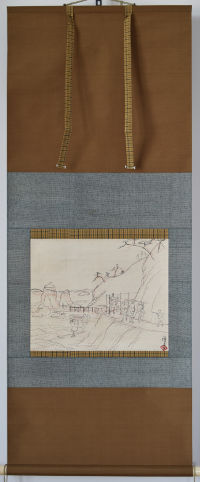
Click here to view image full size.
An original drawing, being a preparatory sketch for a painting, sumi and red under-drawing on paper, mounted as a kakemono. Image size 10.5 x 13 in; 26.5 x 33 cms. An unusual view of the Husband and Wife rocks, Meoto Iwa, “Married Couple Stones,” off Futami, Mie, Japan. They are sacred to the Shinto religion and worshippers flock to the neighbouring Futami Okitama Shrine, which is dedicated to the food goddess Miketsu. In this drawing the emphasis is on the worshippers and travellers seen here in the centre and right.
In very good condition. A spurious signature and seal bottom right. There are others drawings with the same signature and seal on otherwise perfectly genuine works.
Status: Sold

Click here to view image full size.
Hosoda EISHI (1756-1829)

Click here to view image full size.
An original painting, full colour on silk, 32.5 x 10 in; 82.5 x 25.5 cms. Shows a promenading courtesan under a full moon – presumably on the way to an assignation. She wears a vivid red over-garment decorated with iris and the under-garment has heavy mica applied. Eishi was of unusually high rank for an Ukiyo-e artist and is noted for his refined beauties – both painted and in woodblock form. They often have ink-wash backgrounds in the Edo-Kano technique learned as a pupil of Kano Eisen’in Michinobu (1730-90). His corpus is extensive and there are also many copies of his work. He had around thirty pupils including Eisho, Eiri and Eisui. Minor flaking of mica but in otherwise good condition. Signed Chobunsai Eishi hitsu with Eishi seal.
Status: Sold
KAIGETSUDO School

Click here to view image full size.
An original painting, full colour on paper, 39.75 x 15.25 in; 101 x 38.75 cms. Shows a beauty erotically biting a cloth. The kimono is decorated with a strong motif of flowering plants. The school was founded by Kaigetsudo Ando (1671-1743). He had a tight-knit atelier of artists who followed his style of large single standing beauties with bold drapery and small faces. There are many copies of the leading Kaigetsudo artists and it’s refreshing to have an unquestionably authentic painting of the period, c early 1710s. Minor imperfections but all in line with the age of the painting, otherwise good condition.
Status: Sold

Click here to view image full size.
Torii KOTONDO (1900-1976)

Click here to view image full size.
An original painting, full colour on silk with touches of gold, 45.5 x 14.5 in; 115.5 x 36.75 cms. Shows the famous story of the demon Ibaraki of Rashomon (a gate south of the Imperial Palace in Kyoto). The tale relates how Watanabe no Tsuna cuts off the arm of the demon Ibaraki near the Rashomon Gate in 976 to free the neighbourhood of the beast. Watanabe locks the arm in a box. Subsequently he is visited by his wet nurse who asks to see the arm, whereupon she seizes it and flies off revealing her true guise as that of the demon. The story was made into a No play, Ibaraki, and later a Kabuki play. Kotondo is famous for his beauty prints of the late 1920s and early 1930s. In fine condition. Signed Kotondo ga with Kotondo seal.
Status: Sold
Ichiryusai HIROSHIGE (1797-1858)
Click here to view image full size.
A fine original painting by Hiroshige I, sumi on silk, image size 38 x 12.5 in; 96.5 x 31.75 cms. Shows an avenue of trees leading to a small bridge beneath a torii; bands of mist, and, in the distance, another torii and a lake or open sea with sails. A beautiful composition. I have not been able to identify the location: It was not unknown for Hiroshige to paint imaginary landscapes or use poetic license.
Signed Hiroshige ga with Ichiryusai seal. In very good condition having been recently remounted.
Status: Sold
Mori SOSEN (1747-1821)

Click here to view image full size.
A fine original painting, sumi and light colour on silk; 41.75 x 15 in; 106 x 38.1 cms. His life is not well documented but he is known to have studied under the Kano artist Yamamoto Joshunsai (? -1781) before being drawn into Maruyama Okyo’s (1733-1795) artistic circle and his style is more Shijo than anything else. His animal paintings were evidently highly valued by Okyo. He was an immediate favourite with eastern collectors because of his monkey paintings at which he excelled, although he was more versatile than literature implies and highly accomplished at drawing other animals. But his images of monkeys take precedence and he is considered the pre-eminent painter, east or west, on this subject. He is said to have lived in the woods for three years eating fruit and nuts to better study the monkeys and other animals at close quarters. (Even if this is apocryphal it underlines the appreciation of his commitment to understanding the monkey.) Shows two monkeys on a bough beneath a large red sun. In very good condition. Genuine Sosens (and there are many copies) show a great skill in the way their fur coats are built up with hundreds of fine strokes. The box that goes with the painting has an inscription on the lid: “A painting of monkeys by Mori Sosen” and on the underside of the lid is a guarantee by Ayaoka Yushin (a Shijo painter and pupil of Shibata Zeshin, [1846-1910]) signed Ayaoka with seal Yutoku and dated June 1891. The painting signed “Painted by Mori Sosen early spring [=January] 1800” with seals Mori Shusho and Sosen.
Status: Sold
Mori SOSEN (1747-1821)
Click here to view image full size.
An original fan painting of a baby tanuki amongst autumn grasses and beneath a full moon. Sosen was a close observer of nature (even, it is said, living for a while in the woods to closely observe the animals). He is best known for his monkey paintings, of which there are many copies. The tanuki, or Japanese raccoon dog, is frequently depicted in Japanese art and mentioned in the folklore. It was reputed to be a mischievous creature and a master of disguise. Sumi and colour on a gold-flecked paper ground; 8 x 20.5 in; 20.5 x 52 cms. Mounted as a scroll. Old mount and box. An inscription on the inside of the box reads: Kokou Souryo shintei, “Judged by Kokou Souryo.” On the outside the inscription reads: Shunsou-tanuki-senmen, “Autumn grass tanuki fan.”
Sosen hitsu. Painted c. 1800. Signed Sosen with seals Shusho. Good overall condition.
Status: Sold
Hishikawa MOROSHIGE (Fl. 1684-1704)
Click here to view image full size.
An original painting showing a go game being watched by beautifully attired ladies. Moroshige was the senior pupil of Hishikawa Moronobu, and, it is said, was the father of Furuyama Moromasa. Sumi and full colour with extensive gold on silk; 10.75 x 15 in; 27.5 x 38 cms. Newly remounted with futomaki and box. Provenance: Ex William Sturgis Bigelow collection. He was one of the first Americans to live in Japan and much of his extensive collection went to the Museum of Fine Arts, Boston. His original seal has been affixed to the side of the box.
Painted c. 1700. In very good condition. Rare: A fine painting and nice subject.
Status: Sold
Nagasawa ROSETSU (1754-1799)

Click here to view image full size.
An original painting, sumi and light colour on silk, image size 17.5 x 14.25 in; 44.5 x 36 cms. Little is known of Rosetsu’s life: He was a lay student of Zen and a minor samurai. He became a pupil of Maruyama Okyo – the pre-eminent painter in Kyoto – at the age of 25. It is now generally agreed that he surpassed his teacher after some years. There are anecdotes – not verified – regarding his death, his break-up with Okyo and his drinking. Initially strongly influenced by Okyo, but then free of his style, he became highly skilled not only at more formal, finished paintings, but also at quick, spontaneous renditions. Often eccentric and not easily categorized, he was extensively faked in the Meiji period. Shows a reclining female cat who has obviously had a number of litters and a playful kitten.
A background of cherry blossom. The rendition of the furry tail and the character imbued in the face is impressive. Signed Rosetsu in sosho script of his late period (c 1795-1799) with seals Nagasawa (upper) and Gyo ‘Fish’ (lower). Unmounted and slightly cut into lower seal. Framed and glazed.
Status: Sold
Kubo SHUNMAN (1757-1820)

Click here to view image full size.
An original painting, sumi and colour on silk, 37 x 13 in; 94 x 33 cms. Shows a parading courtesan wearing a kimono of subdued colouring, being painted in sumi hues. She provocatively raises the hem of her monochromatic dress to reveal a bright red under-garment. Shunman, a man of great sophistication, designed only a few prints before concentrating on surimono and printing and issuing some of the finest in this format. (See The Japanese Print: A New Approach, J. Hillier, pp. 102-104 where he says “Probably no artist except Choki has achieved so high a reputation on such a small number of prints.”) He also excelled at painting, book illustration and light verse. Above is a poem by Ota Nampo (Shokuzanjin), a famous poet and fiction writer (1749-1823), as well as an occasional painter. In very good condition, signed and sealed Shunman.
Status: Sold

Click here to view image full size.
Utagawa HIROSHIGE (1797-1858)

Click here to view image full size.
An original painting, sumi and light colour on silk, 14.5 x 22 in; 36.8 x 55.9 cms. Labelled on the right Hakone no kosui, “The Lake of Hakone.” Shows the reflection of Fuji in Lake Kawaguchi with the Misaka mountain range. A similar view could be seen from Lake Ashi. Hokusai produced a version for for the Thirty-six Views of Fuji set and this area was the subject of a number of Hiroshige prints. Signed Hiroshige with Ichiryusai seal. In very good condition.
Status: Sold

Click here to view image full size.
Yashima GAKUTEI (1786-1868)

Click here to view image full size.
An original painting, sumi and light blue on silk, 13 x 22 in; 33 x 55.9 cms. Shows a carp swimming amongst weeds. Gakutei is best known for his fine surimono (and in fact designed a surimono of this subject). Painted in Bunsei era (1818-1830). In fine condition apart from a minimal crease. Recently remounted.
Signed Gogaku with seals Yashima and Sadaoka. A beautiful painting.
Status: Sold
Uegaki HORYU (Fl. c 1716-1736)
Click here to view image full size.
An original painting, full colour on paper, 36.5 x 15.5 in; 92.75 x 39.4 cms. Shows a full-length courtesan. It appears there are at least four other Horyu paintings known: Two in the Tokyo National Museum: C0041812 and C0041813; one in the Cleveland Museum of Art; and another in the MFA, Boston, Acc. no. 11.7482. Horyu worked in parallel (and in competition) with the Kaigetsudo atelier. Signed Nihon-e Uegaki Horyu kore o gasu with one Horyu seal; the other unread. The lid of the box is inscribed: Kaigetsudo-ha Uegaki Horyu-hitsu tayu tachi sugata, “A standing figure of a top courtesan brushed by Uegaki Horyu of the Kaigetsudo school.” And on the inside of the lid: Showa hinoto’u uzuki gekan, “Late April of the Fire Rabbit Year [Showa 62/1987].” Appraised by Kimura Suetsuke (a dealer and Ukiyo-e expert). Areas of restoration at bottom and one or two other small areas, but otherwise in very good condition for a painting of this period.
Status: Sold
Watanabe SEITEI (1852-1918)
Click here to view image full size.
Seitei ( Shotei ) specialised in kachoga; was famous in this area, and regarded as the leading exponent. Technically brilliant. A complete set of three paintings showing, right, Hana shobu, “ Iris Flower; centre, Matsu ni koi, “Pine Tree and Carp”; and left, Shobu, “Iris.” Each painting in full colour on silk, image size 47.5 x 20 inches; 120.75 x 51 cms. Signed Seitei. Fine condition. With original double box, signed and sealed.
Status: Sold
Ichiryusai HIROSHIGE (1797-1858)
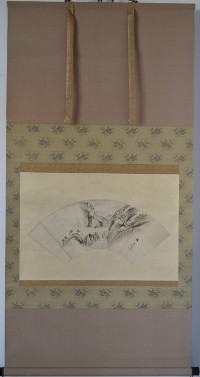
Click here to view image full size.
An original fan painting mounted as a scroll. Shows a gorge with the fast flowing Nagatoro River in Musashi Province. (An area in western Saitama Prefecture northwest of Tokyo.) Sumi and light blue on paper, 7 x 20.5 in; 17.75 x 52 cms. Comes with a certificate from Aoki Shinzaburo (who had a large collection of Hiroshige drawings and paintings). In good condition. Signed Hiroshige with Ryusai seal.
Status: Sold

Click here to view image full size.

Click here to view image full size.
